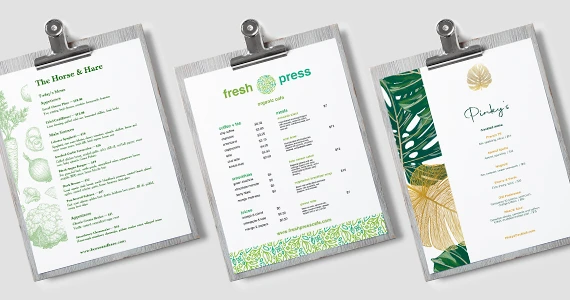While multi-page menus once reigned supreme, the small menu is finally taking center stage at restaurants (and in menu management systems) across North America.
Although restaurant menus have been shrinking for years, the COVID-19 pandemic has accelerated the shift to a more curated list of offerings. On the one hand, a shortage of dine-in customers (and the revenue they bring in) has caused many restaurants to make cost-saving changes such as doing away with lower-margin items and high restaurant prices. In fact, one study found that more than half of operators plan to offer fewer items on their menus moving forward.
But the shift towards smaller menus isn’t just a matter of protecting the bottom line. Consumers are also driving the trend towards small menus by opting for dishes they already know and love, rather than a restaurant’s more obscure offerings. As DoorDash’s mid-year Deep Dish report revealed, customers are overwhelmingly opting for familiar comfort foods like French fries and chicken sandwiches, over healthier options.
Even major restaurant brands notorious for their novel-length menus have begun scaling back their offerings to adapt to the new normal. For example, McDonald’s cut all-day breakfast to shave time off its drive-thru speed, while Cracker Barrel cut several items in an effort to highlight its more popular dishes.
But while a small menu might work for major restaurant chains, how do you know if shrinking your menu size is the right move for your restaurant?
In this article, we’ll help you figure out if a small menu is the right fit by covering:
- The ongoing shift towards smaller menus
- How COVID-19 has impacted menu size
- Eight big benefits of a small menu
Let’s find out why bigger isn’t always better when it comes to menu size.

Creating an eye-catching restaurant menu has never been easier thanks to these free restaurant menu templates.
Why Restaurant Menus Are Shrinking
There’s no question that COVID-19 has accelerated the adoption of small menus. However, this trend has also been in motion for quite some time now.
Before COVID-19
On the one hand, part of the reason for that longer menus have fallen out of favor is simply due to customer behavior. In the past, most restaurateurs assumed that giving customers a wide range of options to choose from would make it easier for them to find their perfect dish. But in early 2000, psychologists Sheena Iyengar and Mark Lepper published a study that revealed that when faced with too many choices, customers are actually more likely to purchase nothing at all – and if they do buy something, they’re less satisfied with their choice.
Iyengar and Lepper’s study confirmed that more choice is not always better, and too many options can actually overwhelm and confuse consumers. In an effort to stem the “choice paralysis” that comes with too many options, many chain restaurants have been gradually shrinking their menus over the years.
However, it’s not just decision fatigue that’s caused menus to shrink, but also growing awareness about environmental concerns. A large menu with dozens of different items means that restaurants need to order more ingredients to create those dishes and there’s a higher risk of food spoilage and waste. In fact, U.S. restaurants alone (including full service and quick service) are estimated to generate a whopping 22 to 33 billion pounds of food waste each year.
Food waste in restaurants is a particular concern to Millennials. Unlike the generations before them, Millennials place a greater emphasis on food that is high-quality, locally sourced, and sustainable – even if that means they have to pay a bit more for it. As a result, Millennials have partially been responsible for the shift to menus that are smaller, but more sustainable.
Post-COVID-19
Now, in the wake of the COVID-19 pandemic, restaurant menu sizes are getting even smaller, but for different reasons.
The COVID-19 pandemic and the dining restrictions that have come with it have left many restaurants with fewer staff, smaller budgets, and reduced operations. As a result, many restaurants no longer have the workforce to prep many different dishes, or the funds to purchase a wide variety of ingredients. In fact, a recent study by One Table found that 60% of operators were purchasing ingredients less frequently than normal.
Not to mention, restaurants are simply simply serving fewer customers right now. With many restaurants operating at reduced capacity or limited to just takeout and delivery, there’s no real audience for dozens of different menu options – especially for restaurants with a core set of best-selling items. In many cases, offering a small menu is the only logical way many restaurants can make their business model work.

8 Benefits of a Small Menu
Whether you were already in the process of pruning your menu, or COVID-19 has forced you to axe a few dishes, going small can lead to some big gains. Below, we’ll dive into the top eight benefits of a small menu for your restaurant.
1. Helps Define Your Restaurant Concept
Though you may not realize it at first, a smaller menu can help you gain clarity on your restaurant concept. When you begin removing dishes and reducing your menu size, think about which ones best align with your restaurant concept and which ones resonate most with your guests. For instance, if you’re a burger and fries kind of joint, maybe you don’t need that fish taco entree or that trendy pumpkin spice shake.
By focusing your energy on only the dishes that reflect your vision for your restaurant, you can better define your brand. Focusing on guest favorites will also make it easier to market your restaurant across channels like social media and online ordering apps, ultimately helping you stand out from your competitors.
2. Improves Efficiency
Not every kitchen is equipped to prepare a wide range of complex dishes. Streamlining your menu can help to ensure that the dishes you serve are ones that your kitchen can handle efficiently and quickly, without placing a burden on your staff, kitchen equipment, or storage space. This is especially important in the wake of COVID-19, as many restaurants continue to operate with skeleton crews or need to keep kitchen staff to a minimum to promote social distancing.
Efficiency is also a major consideration for restaurants changing their business model to adapt to new dining restrictions. For instance, dining room closures caused many fast food chains to refocus their efforts on their drive-thru business. In the case of McDonald’s, eliminating all-day breakfast helped the chain shave 15 seconds off its drive-thru speed and improve the efficiency of this to-go channel.

3. Reduced Labor Costs
Tied to the issue of efficiency is labor costs. When you have an excessively large menu, it takes a greater number of back-of-house staff to prep and cook all the different dishes you offer.
However, when you offer just a few core dishes, you can get away with fewer staff in the kitchen. And with many restaurants dealing with tighter budgets in the wake of COVID-19, reducing the number of staff in the kitchen can be a good way to keep labor costs low.
4. Simplifies Training
Beyond lowering your labor costs, a small menu also can also help to simplify training. For back-of-house staff, a small menu means fewer dishes to learn, allowing them to get up to speed more quickly. A greater focus on a smaller number of dishes can also have the effect of helping to improve consistency and improve the quality of your food overall.
As for your front-of-house team, a small menu means fewer items for servers to remember. This not only makes their lives easier, but it also means they can become more familiar with the dishes you do serve and make better recommendations to your customers.
5. Improves the Customer Experience
While a small menu has many benefits for you and your staff, it’s also beneficial for your customers. As mentioned above, a smaller menu helps to fight decision fatigue, which is when customers are faced with so many choices that they end up feeling unhappy about all of them.
A smaller menu not only easier makes the decision process easier for customers, but it can also help increase the perception of quality. Customers know that restaurants can’t be everything to everyone, and a large menu size can make it seem as though your efforts are not focused. By limiting your menu to just a few offerings, it sends a message to customers that these dishes are your specialties.
6. Simplifies Online Ordering
Another major benefit of a small menu is that it can help you simplify your online ordering operations. By removing items that don’t travel well or take too much time to package, you can streamline the process of preparing takeout and delivery orders. This is something that fine dining restaurants such as San Francisco’s SPQR have done in an effort to make gourmet offerings more takeout-friendly.
A small menu also improves the online ordering process for your customers as well. A lengthy online menu is difficult for consumers to navigate on a small screen like an iPhone, while a small menu makes the selection process quick and easy. This is an important consideration when signing up with third-party delivery apps or adding a direct online ordering integration to your website.

7. Reduces Food Waste
One of the most obvious benefits of a small menu is that it helps to reduce food waste. With fewer dishes on your menu, the question of how to do inventory in a restaurant becomes much simpler because it’s easier to keep track of how much you need of any given ingredient or to figure out which ingredients can be cross-utilized in multiple dishes.
And with more precise ingredient tracking, it’s easier to stay on top of your current inventory, avoid over-ordering in the future, and order locally when possible – all of which helps to prevent spoilage and food waste. This is the approach the Chinese fast-casual spot Junzi Kitchen took in the early days of the pandemic. By limiting its menu to select favorites and seasonal specials, the multi-location restaurant was able to reduce food waste.
8. Boosts Your Bottom Line
Finally, and perhaps most importantly, a small menu is good for your bottom line. Fewer items on the menu means fewer ingredients to order and the opportunity to order in bulk for the things that you do need. Not to mention, if you’re reducing spoilage, you’re reducing the financial loss of food waste.
A small menu is also easier to manage, making menu engineering more feasible. Menu engineering is the process of analyzing the profitability and popularity of individual menu items, and then strategically structuring your menu to increase profit per guest (as opposed to trying to create a menu by just hitting food cost percentages). With a smaller menu, it’s much easier to tweak your menu by removing lower-margin items, utilizing less expensive ingredients, and structuring your offerings to maximize profitability.
Just take the example of Cracker Barrel, which consolidated several menu items with the fastest ticket times and highest margins into a “Cracker Barrel Favorites” category, and then spotlighted these items in the center of the menu.

Creating an eye-catching restaurant menu has never been easier thanks to these free restaurant menu templates.
Of course, a small menu is not the right decision for every restaurant and multi-page menus can certainly have their place. But in the wake of COVID-19, it’s clear that there are many advantages to shrinking your menu size. Not only does it make the ordering process easier and more enjoyable for your customers, but a small menu can also come with huge cost savings – something that can help every restaurant.
Download our free inventory template
Sign up for our free weekly TouchBistro Newsletter







